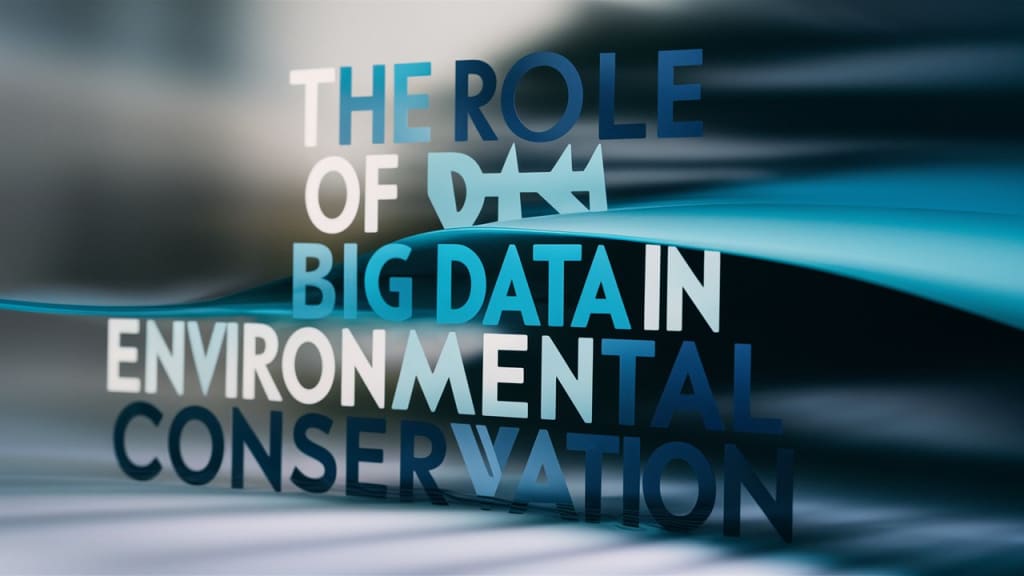The Role of Big Data in Environmental Conservation
How Data-Driven Insights are Saving Our Planet

Introduction
In today's digital age, the term "big data" has become a buzzword across various industries. But did you know that big data is also playing a crucial role in environmental conservation? By collecting, analyzing, and interpreting vast amounts of data, scientists and conservationists are gaining new insights into our planet's health and devising effective strategies to protect it. This article explores how big data is revolutionizing environmental conservation, from monitoring wildlife populations to predicting climate change impacts.
Click Here for Revolutionizing Your Store with Seamless Dropshipping!
What is Big Data?
Big data refers to the massive volume of data that is generated every second from various sources such as social media, sensors, satellites, and more. This data is characterized by its volume, velocity, and variety, and requires advanced technologies to process and analyze it.
Characteristics of Big Data
Volume: The sheer amount of data collected, often in terabytes or petabytes.
Velocity: The speed at which data is generated and processed.
Variety: The different types of data, including text, images, video, and sensor data.
Big Data in Environmental Conservation
Big data is being harnessed in numerous ways to protect and preserve the environment. Let's delve into some of the key applications.
Wildlife Monitoring and Protection
Big data is instrumental in tracking wildlife populations and movements, which helps in the conservation of endangered species.
Satellite Tracking
Satellites equipped with GPS technology provide real-time data on animal migrations, habitat use, and population dynamics. This information is crucial for developing conservation strategies and protecting critical habitats.
Acoustic Monitoring
By analyzing sound recordings from forests and oceans, scientists can monitor the presence and behavior of various species. This method is particularly useful for studying elusive or nocturnal animals.
Camera Traps
Motion-activated cameras capture images and videos of wildlife in their natural habitats. The data collected helps researchers estimate population sizes and monitor the health of ecosystems.
Climate Change Analysis
Big data plays a vital role in understanding and mitigating the impacts of climate change.
Weather Predictions
Advanced algorithms analyze historical weather data to predict future climate patterns. These predictions help governments and organizations prepare for extreme weather events and develop climate-resilient infrastructures.
Carbon Footprint Tracking
Big data helps in tracking carbon emissions from various sources, including industries, transportation, and agriculture. This information is crucial for formulating policies and measures to reduce greenhouse gas emissions.
Natural Disaster Management
Big data is essential for predicting and managing natural disasters, such as hurricanes, earthquakes, and floods.
Early Warning Systems
By analyzing seismic data, meteorological data, and other relevant information, scientists can predict natural disasters and issue early warnings. This allows for timely evacuations and preparations, saving lives and minimizing damage.
Disaster Response
During and after a disaster, big data helps in coordinating rescue and relief efforts. Satellite images and social media data provide real-time information on affected areas, guiding responders to where help is most needed.
Resource Management
Big data supports sustainable management of natural resources, ensuring their long-term availability.
Water Resource Management
Sensors and satellites monitor water quality, levels, and usage. This data is used to manage water resources efficiently, preventing shortages and ensuring equitable distribution.
Click Here for Revolutionizing Your Store with Seamless Dropshipping!
Forest Conservation
Big data helps in monitoring deforestation and forest degradation. Satellite imagery and drone data provide insights into forest cover changes, aiding in the enforcement of conservation laws.
Pollution Control
Big data is crucial for monitoring and controlling pollution, improving air and water quality.
Air Quality Monitoring
Sensors placed in urban areas collect data on air pollutants. This information helps in identifying pollution sources and implementing measures to improve air quality.
Water Quality Monitoring
Sensors and satellite data monitor water bodies for pollutants. This data is essential for protecting aquatic ecosystems and ensuring safe drinking water.
Case Studies: Big Data in Action
Let's look at some real-world examples of how big data is being used for environmental conservation.
Saving the Elephants
In Africa, big data is being used to combat elephant poaching. GPS collars on elephants provide real-time location data, which is monitored by conservationists. If an elephant enters a high-risk area, rangers are alerted and can intervene to prevent poaching.
Coral Reef Protection
Big data is helping to protect coral reefs, which are vulnerable to climate change and human activities. Satellite imagery and underwater sensors monitor reef health, providing data on water temperature, acidity, and other factors. This information guides conservation efforts to preserve these vital ecosystems.
Amazon Rainforest Monitoring
In the Amazon, satellite imagery and machine learning algorithms are used to detect illegal logging and deforestation. By analyzing changes in forest cover, authorities can identify and take action against illegal activities, protecting the rainforest and its biodiversity.
Challenges and Solutions
While big data offers significant benefits for environmental conservation, it also comes with challenges.
Data Quality and Reliability
The accuracy and reliability of data are critical for effective decision-making. Inconsistent or incomplete data can lead to incorrect conclusions and ineffective actions.
Solution: Implementing rigorous data validation processes and using multiple data sources can enhance data quality and reliability.
Data Privacy and Security
The collection and use of big data raise concerns about privacy and security. Sensitive information, such as the locations of endangered species, must be protected from misuse.
Solution: Establishing strict data governance policies and using advanced encryption technologies can safeguard data privacy and security.
Technical Expertise
Analyzing big data requires specialized skills and expertise. There is a shortage of professionals with the necessary knowledge and experience to effectively harness big data for environmental conservation.
Solution: Investing in education and training programs can build the necessary technical expertise in the field of big data and environmental conservation.
Funding and Resources
Big data projects can be costly, requiring significant investment in technology and infrastructure. Limited funding can hinder the implementation of big data initiatives for environmental conservation.
Solution: Collaboration between governments, NGOs, and private sector organizations can pool resources and share the costs of big data projects.
The Future of Big Data in Environmental Conservation
The future of big data in environmental conservation looks promising, with continued advancements in technology and increasing awareness of its potential.
Artificial Intelligence and Machine Learning
AI and machine learning are expected to play a more significant role in analyzing big data. These technologies can identify patterns and trends that humans might overlook, providing deeper insights into environmental issues.
Increased Connectivity
The expansion of IoT and 5G networks will enable the collection of even more data from remote and hard-to-reach areas. This increased connectivity will enhance the monitoring and management of natural resources and wildlife.
Citizen Science
Citizen science initiatives, where volunteers collect and share data, will become more prevalent. These initiatives can significantly expand the scope of data collection, involving communities in conservation efforts and raising awareness about environmental issues.
Policy and Advocacy
Big data will continue to inform policy and advocacy efforts, providing evidence-based insights that can shape environmental regulations and conservation strategies. As policymakers increasingly recognize the value of data-driven decision-making, big data will become an integral part of environmental governance.
Click Here for Revolutionizing Your Store with Seamless Dropshipping!
Conclusion
Big data is a powerful tool that is transforming environmental conservation. By providing detailed and accurate insights into our planet's health, it enables scientists, policymakers, and conservationists to make informed decisions and take effective action. From monitoring wildlife to predicting climate change impacts, big data is helping to protect our natural world and ensure a sustainable future. As technology continues to advance, the potential for big data in environmental conservation will only grow, offering new opportunities to preserve and protect our planet for generations to come.
About the Creator
Enjoyed the story? Support the Creator.
Subscribe for free to receive all their stories in your feed. You could also pledge your support or give them a one-off tip, letting them know you appreciate their work.






Comments
There are no comments for this story
Be the first to respond and start the conversation.